Modern Methods of Foot Correction as the Main Cause of their Deformities
Valentyn Gusyev*
Doctor of Natural Medicine, Osteopathy at Scientific Research Centre of Functional Orthopaedics, Canada
Submission: July 08, 2023; Published: August 10, 2023
*Corresponding author: Valentyn Gusyev, Doctor of Natural Medicine, Osteopathy at Scientific Research Centre of Functional Orthopaedics, Canada Email: gusyevval@hotmail.com
How to cite this article: Valentyn G. Modern Methods of Foot Correction as the Main Cause of their Deformities. J Head Neck Spine Surg. 2023; 5(1): 555654. DOI: 10.19080/JHNSS.2023.05.555654
Keywords: General Center of Gravity; Feet; Arches of the Feet; Muscles; Cuboid Bones; Plantar Aponeurosis; Subtalar Joint; Body Cells
Opinion
This question may seem strange to physicians, but how will they explain that over the past 60 years, the percentage of deformities of the feet and spine has increased from 7-19% to 87-95%. Such rapid growth has not been observed in previous centuries. Maybe because until the last 60 years, medicine has not been so actively involved in the correction of the feet, as it is happening today. Or the problem is that medicine is not a science, it does not know mechanics, it is engaged in healing a self-regulating system. Today, the doctor eliminates the symptoms of diseases, but not their causes. There is no understanding of the relationship between the state of body systems and deformations in the structures of the musculoskeletal frame of the body responsible for cell metabolism. Deformities cannot be classified as a disease.
The concept of deformation refers to the section of mechanics, biomechanics, from the standpoint of which they can be qualitatively assessed, described and explained. So, displacements in the joints are a consequence of the action of forces that the muscles cannot compensate. When they cannot cope with the load, the ligaments perceive it, subluxations occur, the bones are abraded, they are displaced from a neutral position balanced by the muscles. If, after the termination of the action of forces, the muscles do not return the bones to their original neutral position, then this is a deformation. Two components are involved in this process: strength and muscle tone. Static and dynamic forces acting in each of the planes determine the direction and degree of displacement of the bones. These forces arise when the General Center of Gravity of the body deviates from the axis of symmetry of the skeleton (Figure 1). And although there really is a physiological relationship between deformations and disorders in the work of the vein-muscular pumps of the body with cell metabolism, doctors do not pay attention to this. Their actions are not aimed at identifying the root causes of impaired muscle pumping function. If we understand that the displacement of the BCT of the body occurs due to the anatomical difference in the lengths of the legs that each individual has, then it is the root cause of the development of all disorders in the body (Figure 2). Determining the anatomical difference in the lengths of the legs should be the first priority for specialists involved in foot corrections, and hence the spine, all skeletal structures up to the level of the vestibular apparatus.
Another component that determines the nature of the deformation is the strength of the muscles, their ability to compensate for the load. There is no flow here about the ability to measure muscle tone. It is enough to separate them by type, muscle tone (Figure 3). So, in 80% of people, the muscles are in a state of hypertonicity and require relaxation, relaxation. 15% of the inhabitants have weak muscles, they are in hypotonicity. It is possible to strengthen them through gymnastics. So according to these features, two types of people are distinguished. Some are hyperactive, very mobile, they are said to be fidgety. The foot is characterized by a high rise, these people run well for short distances, have chronic stomach problems: heartburn, gastritis, constantly feel cold feet and hands. The other type includes calm, sedentary people, prone to flat feet, constipation.
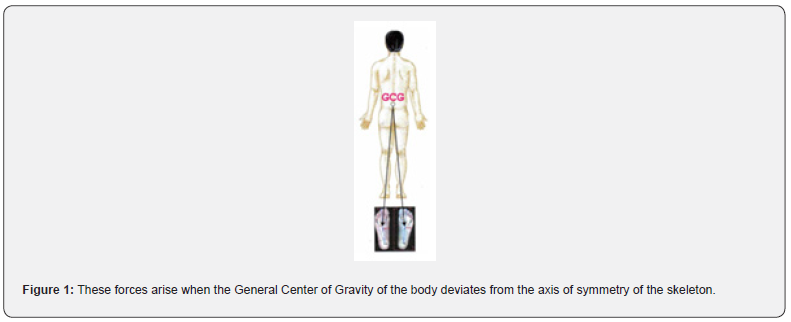
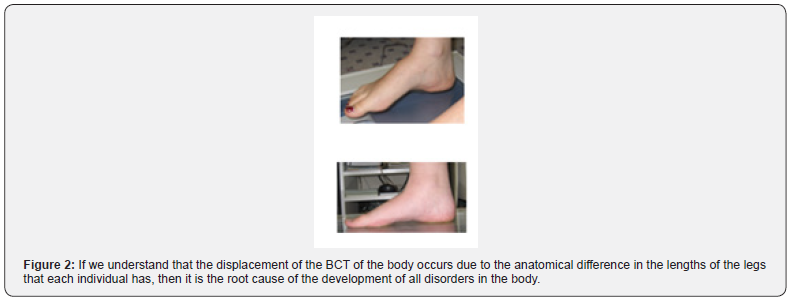

It is very easy to take into account and compensate for the load in accordance with muscle tone, knowing the laws of hydrostatics, methods of muscle relaxation and correction of the feet, the entire musculoskeletal frame of the body (Figure 4). This is knowledge of the anatomy and biomechanics of the feet, the physiology of the body. So standing on the diaphragms of the communicating vessels, the system compensates for the anatomical difference in the lengths of the legs and the spine is aligned, the body takes a stable vertical position. When the weight of the body, the pressure on the arches of the feet is directed vertically from top to bottom, and the Pascal forces equal to the mass of the body act from the bottom up, then the arches of the feet occupy a neutral position (Figure 5). Taking footprints in this position, we can determine at what height of the heel of the shoe the arches will be in a balanced state, which limb is shorter. When using polar polymers as prints, the material captures information about the energy state of the body. This is tested and shows how the correction of the musculoskeletal framework of the body affects the state of the body (Figure 6). With hydrostatic correction of the body frame, this normalization is observed in 99% of cases, the symptoms of diseases disappear. This indicates that it is impossible to subjectively assess the quality of the insoles, the methods of their production.




Kinematics of development of Flat Feet
Considering the functionality of the internal arch of the feet, the reason for the decrease in the height of the lumen under it, this process should be associated with the position of the body’s BCT relative to the spherical protrusion on the calcaneus, with which the talus of the arch forms the subtalar joint (Figure 7) (4). Medicine incorrectly interprets which bones are part of the internal arch (3-4). Without considering the kinematics of their conjugation, it includes the calcaneus, which forms the outer arch, into the composition of the arch (Figure 8). Among doctors, there is no understanding of the functionality of the supporting arches: external (1-2) and transverse (2-3), that all foot deformities begin with them. It is the outer arch that determines the moment of the beginning of the turn of the inner arch at the subtalar joint (Figure 9).
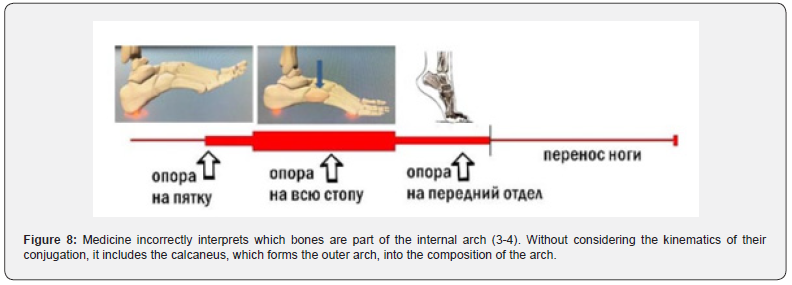
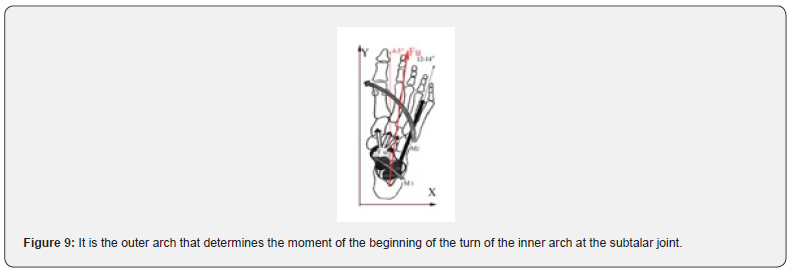
This reversal occurs for three reasons:
a) Depreciation cycle damping the speed of the transfer of the leg.
b) Compensation for the difference in limb lengths and violation of the biomechanics of walking.
c) 3- incorrect location of the support wheelbarrows in the shoes, inconsistency with the reference points of the skeleton.
All these reasons, as a rule, are combined at the same time, which does not allow us to focus on only one of the problems. Since everyone has an anatomical difference in leg lengths, more than 90% of shoes are incorrectly made, without the use of shoe lasts. The main reason for the flattening of the arch is associated with its shock-absorbing function (Figure 10). What medicine takes for flat feet is the result of dampening the speed of transfer of the leg when it is placed on the ground. The beginning of this turn occurs in the second phase of walking, when the vaults rest on 3 points. This is the phase of depreciation (cushioning) of the external arch, lowering and touching the supporting surface of the cuboid bone (Figure 11). Relative to this point, an overturning moment of forces occurs relative to the subtalar joint. This is a command to the inner vault to turn, its overturning.
The process of depreciation and damping by the arch of speed is long in time. It can be compared to the stopping distance of a car. The vault does not descend vertically like the top of the external vault but moves along a radial path relative to the subtalar joint (Figure 12). The whole process of dampening the speed and returning to the initial state is 60% of the time period of the step, in which the acceleration forces of 3-7g are extinguished to zero. Upon completion of the turn, the stretched plantar aponeurosis, peroneus, and tibia muscles elevate the cuboid to its superior position. After that, the internal arch returns to its original position on the subtalar joint, the bones of the internal and external arches form a rigid frame, allowing the BCT to move forward and upward.
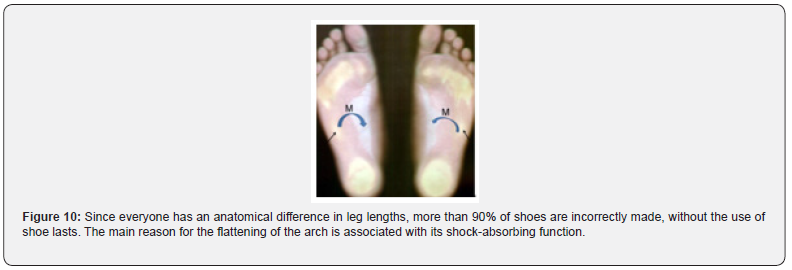
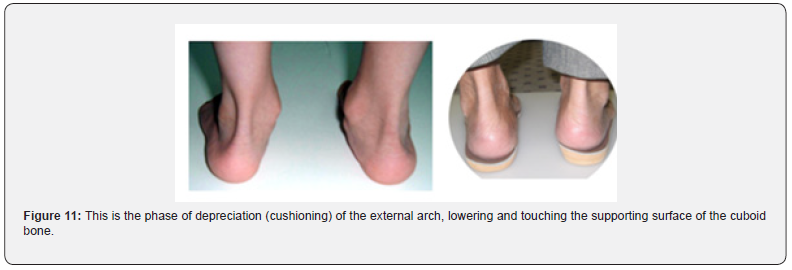
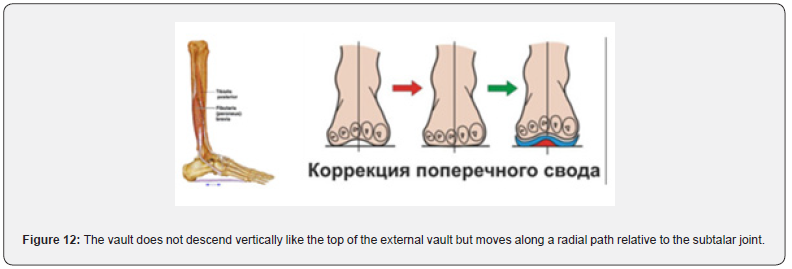
The neutral position of the subtalar joint provides the foot, like any other joint, with dynamic stability, which prevents accelerated wear of cartilage rubbing surfaces (Figure 13). This is how a new supporting triangle of the foot is formed, allowing you to walk, dance on your fingers, perform a push and jump, giving the body a forward movement. This is followed by the release of the other leg, placing the heel on the support. Walking is a drop in the GCG of the body. All this is included in the concept of the five-phase biomechanics of walking, the inherent sequence of muscle contraction, the work of pumps that raise blood to the heart (Figure 14). This is a natural and important cycle, which is violated by modern insoles manufacturing technologies. They are the cause of circulatory disorders in the body, which can explain the increase in the number of patients, among whom the violation of arterial blood flow is in the first place in terms of mortality.
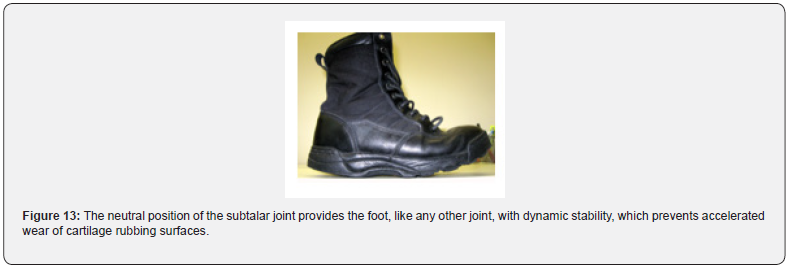
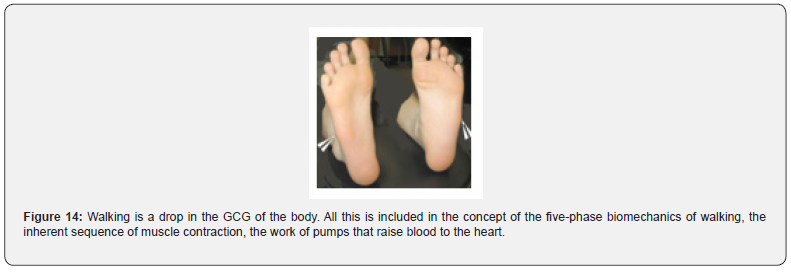
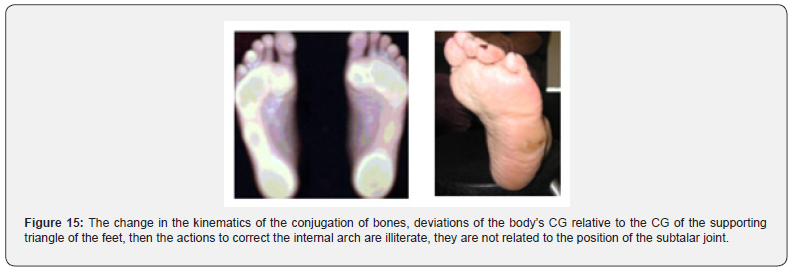
When flat feet are considered as a decrease in the height of the internal arch, without understanding the reasons for the change in the kinematics of the conjugation of bones, deviations of the body’s CG relative to the CG of the supporting triangle of the feet, then the actions to correct the internal arch are illiterate, they are not related to the position of the subtalar joint (Figure 15). This is described in the works of Root M., e.a., 1977. But and he did not indicate the relationship between the difference in leg lengths and the position of the body’s GCG, as the main cause of bone displacements in the joints.
Another reason why flattening of the arch under one limb is observed is associated with functional shortening of the long limb and a violation of the biomechanics of walking, turning one or both feet with the toes outward. So, the projection of the GCG of the body goes beyond the area of support of the arches of the feet, there is an overturning moment of forces on the subtalar joint. Proper walking is when the feet are parallel. We put them in this position when we run, when the load on the joints of the legs reaches (3-5) g. It is possible to eliminate the turn on a long leg only by turning it, placing the calcaneus in a vertical position on a long limb, and then compensating for the anatomical component under the short leg. A metal supinator plate was always installed in the shoes, which kept the heel from turning relative to the reference points of the transverse arch, preventing the calcaneus from turning, and keeping the subtalar joint in a neutral position (Figure 16). When walking, transferring the load from the heel to the forefoot, you must simultaneously stand on the heads of the first and fifth fingers. In this case, the load will pass through the top of the arch and it will not deform.
Correction of the internal arch cannot be performed without correction of the external and transverse arch. Giving them an arched shape due to rigid support will not allow muscles to contract, which leads to their atrophy. In this case, it is impossible to raise the vaults, transferring the load from the supporting bones of the skeleton to the soft tissues of the fascia. The transverse arch pilot must raise the heads of the lowered bones, be between them, and not be set in the center of the soles at a distance of 0.96 from the length of the foot. When issuing insoles, it is necessary to explain to the patient how to properly hold the feet when walking, what reference points should be in the shoes. All this was laid down in the construction of blocks for the manufacture of shoes. Today, mass footwear is made mainly by the shoeless method. The third reason for the flattening of the inner arch is the sagging of the apex (cuboid bone) of the outer arch as a result of improperly made shoes. In it, the support points do not correspond to the support points of the foot skeleton. This is the tubercle of the calcaneus and the heads of the first and fifth metatarsal bones. This type of deformation began to be tested in the last 20-25 years, starting from 2000. In this picture, the cuboid bone was visible as a white pearl. The wound began to heal only after walking on subcorrector insoles that unloaded the patient for 2-3 weeks. All these are examples of how important it is to correct the foot correctly, what orthopedic insoles are and what their tasks are.
It should be understood that by raising the inner arch with an insole, depriving the arch of the ability to turn around on the subtalar joint, filling the gap under it, the orthopedist artificially makes the foot equivalent to flat feet. So, there are problems of violation of arterial circulation in the limbs, the development of gangrene due to a violation of the outflow of venous blood, the sequence of contraction of the muscles of the venous-muscular pumps. Overpronation on both feet also occurs when walking with the feet turned outward. The greater the angle of abduction of the feet, the greater the overturning moment. By placing the feet parallel, the calcaneus and lateral bones will take a natural position without the use of an insole. Therefore, when correcting the arches, it is necessary to pay attention to the nature of the gait. You need to walk keeping your feet parallel to each other. It is laid down by nature. This is how we run and this is how we need to keep our feet when walking (Figure 17).
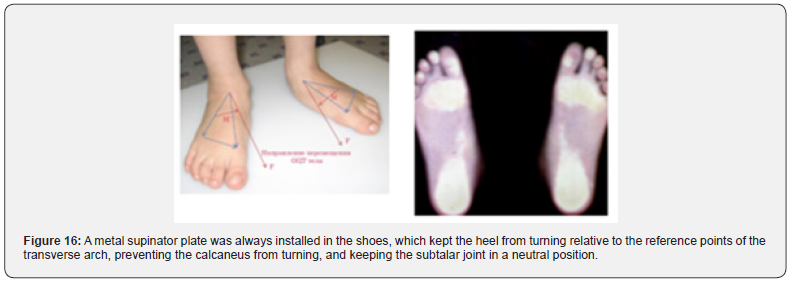
Another important function of the inner vault, which consists of five joints, is the ability to lay down on a complex curvilinear ground surface. When reference points appear under any point of the outer arch, then on the opposite side of the inner arch its pronation will be observed - overhanging. That is why it is so important how the heel of the shoe stands, where its anchor points are, its height corresponds to the neutral position of the arches. Not one, but all three. Without this, it is impossible to eliminate the distortion on the iliac-sacral joints of the pelvis, the support of the spine, which are the root causes of the formation of scoliotic posture. All these actions will eliminate disturbances in the work of lymphatic and venous-muscular pumps, metabolic processes of body cells. In its pure form, flat feet are rare, it’s still the same 7-19%. All other variants of supporting arch deformities are derivatives associated with deformation of the supporting arches, deviations of the calcaneus from the vertical on a long limb with strong muscles and on a short limb with weak muscles (Figure 18). Such a relationship requires taking into account muscle tone, without which it is difficult to determine which limb is shorter.
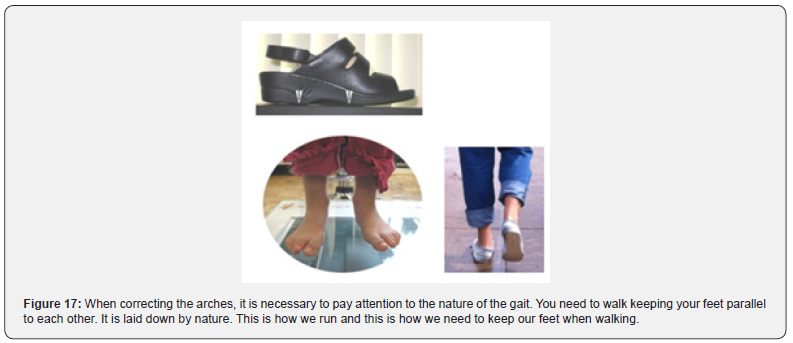
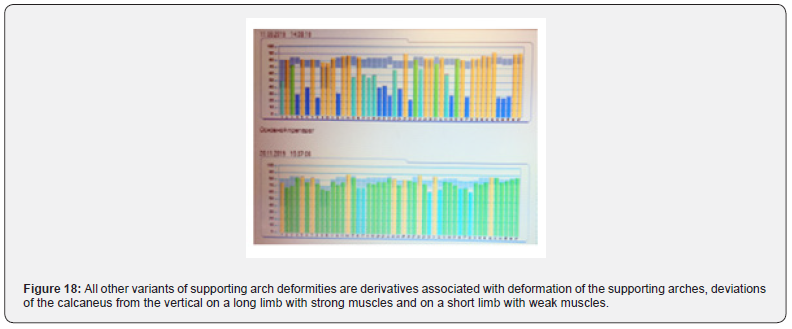
Incorrectly made shoes and incorrect walking only add to the statistics of the development of deformities. The foot is in the shoe for a long time and the work of the muscles is limited. Muscles do not contract on a hard surface. The heel and back of the shoe must be firm and not deform when walking. Complex forms of deformities of the fingers and calcaneus began to be tested in children under the age of 2-5 years. The thumb in the shoe should stand straight. It is he and his muscles that provide the rise of blood and lymph. They can be called the most powerful pump in the body. Therefore, the formation of the transverse arch, the position of the fingers should begin from the moment the child begins to walk, and not like this two-year-old girl, who was recommended for surgery.
Specialists who make orthopedic insoles work with skeletal structures that lie at the level of the ankle joint. So, the knee and hip joints, and with them the position of the pelvis, became ownerless. There is no one to correct posture, to help the body restore its functions. Foot deformities cannot be considered outside the relationship with the state of the spine, with the biomechanics of walking. Otherwise, the meaning of stop correction is distorted. The overload of the central nervous system is also not taken into account, which, together with the vestibular apparatus, ensures the stability of the body, brings the head and the vestibular apparatus into a vertical position, spending 96% of the body’s energy on this. Misunderstanding of the root causes always leads to incorrect actions, which in turn further disrupt the functionality of the body.
Being engaged in the correction of the musculoskeletal framework, it requires from specialists the knowledge and ability to work with the load, the reactions of the forces that perceive the paired muscles of the joints. For their activity and performance, the internal organs and how the muscles support their nutrition, the removal of decay products are responsible. So, the chain of relationships in the body closes on the correction of the feet, the spine, which requires the ability to determine and compensate for the root cause of the development of all disorders: the anatomical and functional difference in the lengths of the limbs. By eliminating deformities of the feet and spine, it means restoring the body’s selfregulating function. Functional correction of the musculoskeletal framework is the restoration of the body’s self-regulating function.






























